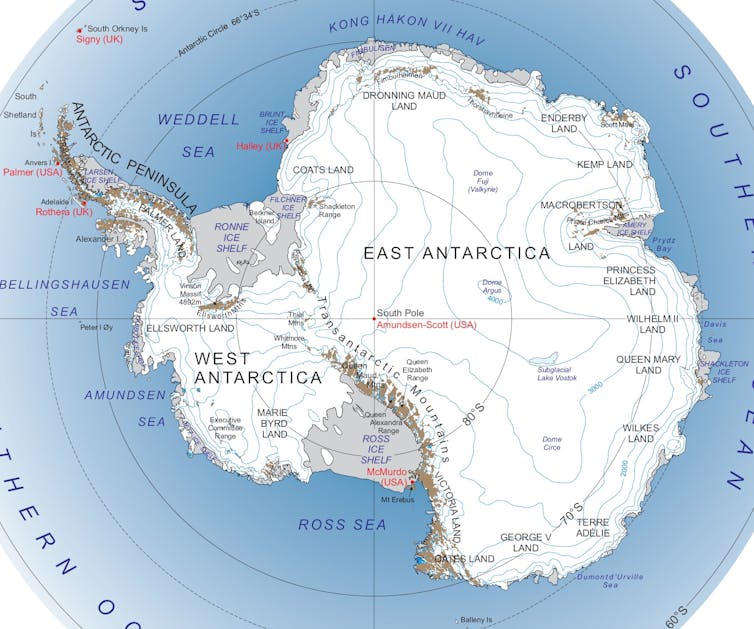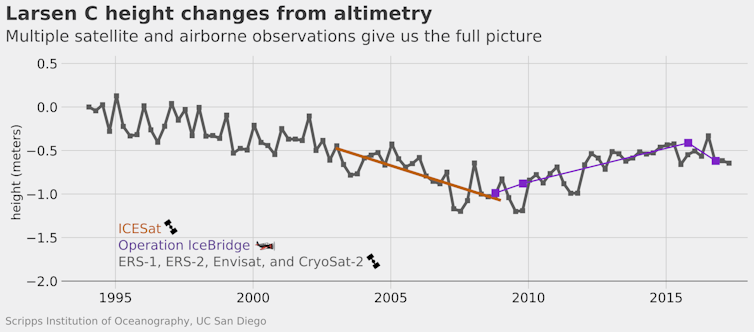Short-term changes in Antarctica's ice shelves are key to predicting their long-term fate
- Written by Helen Amanda Fricker, Professor, Scripps Institution of Oceanography, University of California San Diego
Antarctica’s ice sheet contains enough ice to raise global sea levels by around 180 feet if it all melted. But dramatic, eye-catching changes to Antarctica’s floating ice shelves, such as calving icebergs, are often highlighted in the news without a sense of long-term context or a clear connection to what is causing the changes.
Antarctica is losing land ice[1] at an accelerating rate, and current observations suggest it will become the largest contributor to sea level rise[2] by the middle of this century. Understanding variations in the height of Antarctic ice shelves – the floating edges of the continent’s ice sheet – can tell us how and why Antarctica is changing, and what that could mean for future sea levels.
We study changes[3] in Antarctic[4] ice[5] shelves, along with our colleague Laurie Padman[6] at Earth & Space Research[7], a nonprofit institute in Seattle. One of us, Helen Amanda Fricker[8], contributed to two articles in a special issue of the journal Nature[9] that brings together current understanding of the state of Antarctica. Here’s what we see happening.
 Antarctica’s major geographical features, including the West and East Antarctic ice sheets, the Antarctic Peninsula and some of the larger ice shelves around the continent’s edges.
NASA[10]
Antarctica’s major geographical features, including the West and East Antarctic ice sheets, the Antarctic Peninsula and some of the larger ice shelves around the continent’s edges.
NASA[10]
Ice shelves hold back the grounded ice
Antarctic ice shelves provide mechanical support to hold back the flow of ice from the continent to the ocean, regulating the pace of mass loss from the enormous ice sheet. Scientists call this process “buttressing,” since it works in the same way that an architectural buttress[11] prevents a building from collapsing.
Reducing the mass of an ice shelf does not contribute directly to sea level rise, since this ice is already floating on the ocean, but it promotes faster discharge of grounded ice, which increases sea level. To understand how Antarctic mass loss varies, we need to understand how ice shelves grow and shrink.
Ice shelves gain mass mainly through ice flowing from the continent and local snowfall on their surfaces. They lose mass primarily through melting by the ocean and by iceberg calving.
Antarctica has more than 300 ice shelves, and the net change in their mass is a delicate balance between gains and losses. Determining this balance requires understanding how ice, ocean, and atmosphere interact to drive changes around Antarctica. Climate change will alter the overall balance between gains and losses, and will determine the future of Antarctica’s ice loss[12].
The critical role of satellites
Antarctica’s small ice shelves are roughly the area of small cities, and its largest is the size of Spain. The total ice-shelf area is around 1.5 million square kilometers (580,000 square miles), about as large as Mongolia. The only viable way to routinely monitor changes in their mass is with satellites.
Since the launch of Landsat 1[13] in 1972, satellite data have taught us a lot about the ice sheet, including its large-scale structure, surface properties and flow rates. A recent synthesis[14] combined 150 independent estimates of ice-sheet mass loss from satellite data and atmospheric models to show that the ice sheet is losing more mass to the ocean with every passing year. The largest changes have occurred in places where ice shelves have either thinned or collapsed.
Single satellite missions typically only last five to 10 years, but we can stitch together data from consecutive missions to increase the length of the record. This helps us separate long-term trends from natural climate variability and unravel processes that drive changes around the margins of Antarctica.
The European Space Agency (ESA) has launched four ice-observing satellites since 1992, carrying radar altimeters to precisely determine the distance between the satellite and the Earth’s surface beneath it. These data have now provided a continuous time series of variations in ice-shelf surface height since the early 1990s. Combining measured increases and decreases in surface height with the latest generation of climate models to infer how the atmosphere has changed, we can estimate the amount of mass an ice shelf can lose to the ocean.
Work by researchers at Scripps Institution of Oceanography reveals that strong El Niño events can cause significant ice loss in some Antarctic ice shelves.El Niño and La Niña affect ice shelves
The Pacific Ocean sector of the Antarctic Ice Sheet is experiencing exceptionally high mass loss. This sector contains the rapidly changing Thwaites Glacier, which is the focus of a new major research initiative[15] between the U.S. National Science Foundation and the United Kingdom’s National Environmental Research Council.
The 23-year altimeter record revealed long-term mass loss in the Pacific sector ice shelves[16]. Further analysis of these data showed that in addition, the El Niño/Southern Oscillation (ENSO)[17] – a periodic variation in sea surface temperatures and pressure over the tropical eastern Pacific Ocean – caused additional height change fluctuations.
Strong El Niño events, which typically bring warmer ocean waters and increase precipitation, increase snowfall over these ice shelves. But they also increase ocean-driven melting, removing ice from the ice-shelf base. Since snow is less dense than solid ice, mass lost through melting exceeds that added by snowfall. The result is that total ice-shelf mass, and hence its buttressing capability, actually decreases during El Niño events even though the height of the ice shelf may increase.
The opposite occurs during La Niñas, the counter to El Niño, where tropical ocean waters cool. Scientists expect that total precipitation and the frequency of extreme ENSO events will increase as Earth’s atmosphere warms[18], which implies that yearly fluctuations of ice shelf thickness and mass will also increase.
Atmospheric conditions affect the Antarctic Peninsula
A region further north in Antarctica, the Antarctic Peninsula, has experienced startling changes over the past three decades[19]. Here several ice shelves have catastrophically collapsed due to warming in the atmosphere. Scientists see this as a canary in the coal mine: Similar warming events could drive the collapse of more southern ice shelves, which can play a larger role in future sea level rise.
Extensive press coverage of the 2017 calving of a Delaware-sized iceberg[20] from Larsen C Ice Shelf has aggravated such concerns. However, in a recent study we showed that the height of the remaining Antarctic Peninsula ice shelves across the region has increased since 2009[21]. Using atmospheric models backed up by field observations, we connected this height recovery to a regional cooling that persisted for several years and reduced summertime surface melting. The large calving event was likely a normal mass loss process, similar to a larger event in 1986[22]. There is so far no clear indication that Larsen C is on the brink of collapse.
 Height changes observed over Larsen C Ice Shelf from Four European Space Agency satellites, one NASA satellite and an extensive airborne survey from NASA’s Operation IceBridge.
Helen Fricker, CC BY-ND[23]
Height changes observed over Larsen C Ice Shelf from Four European Space Agency satellites, one NASA satellite and an extensive airborne survey from NASA’s Operation IceBridge.
Helen Fricker, CC BY-ND[23]
The role of the atmosphere is only part of this story. After removing the effect of higher air temperatures, we found that the ocean continued to melt the ice shelves’ bases at a rate that tipped the scales toward net mass loss. In fact, we found that the atmosphere recently played a stabilizing role while the ocean exerts a continuing destabilizing influence, highlighting the complex interplay between the atmosphere, ice and ocean around Antarctica.
New satellites will provide more insight
With existing data, scientists can begin to decode the intricacies of ice-shelf evolution to improve our understanding of what is influencing ice-shelf mass changes and stability.
Satellites have shown that the ice shelves are shrinking overall due to increased ocean-induced melting. In addition to the overall trend, signals corresponding to atmospheric and oceanic processes are becoming apparent, such as influences from El Niño and La Niña cycles in the tropics and local atmospheric changes.
As the satellite record lengthens with the launch of new polar-orbiting satellites like NASA’s ICESat-2[24] in September 2018 and NISAR[25] in 2020, scientists expect to reach the point where we can confidently include these processes in models of ice-sheet response to climate changes, which will improve projections of future sea level rise.
References
- ^ losing land ice (theconversation.com)
- ^ largest contributor to sea level rise (www.nasa.gov)
- ^ changes (scholar.google.com)
- ^ Antarctic (scholar.google.com)
- ^ ice (scholar.google.com)
- ^ Laurie Padman (www.esr.org)
- ^ Earth & Space Research (www.esr.org)
- ^ Helen Amanda Fricker (scholar.google.com)
- ^ special issue of the journal Nature (www.nature.com)
- ^ NASA (commons.wikimedia.org)
- ^ architectural buttress (www.britannica.com)
- ^ future of Antarctica’s ice loss (dx.doi.org)
- ^ Landsat 1 (landsat.usgs.gov)
- ^ recent synthesis (dx.doi.org)
- ^ new major research initiative (www.bbc.com)
- ^ long-term mass loss in the Pacific sector ice shelves (doi.org)
- ^ El Niño/Southern Oscillation (ENSO) (oceanservice.noaa.gov)
- ^ frequency of extreme ENSO events will increase as Earth’s atmosphere warms (doi.org)
- ^ startling changes over the past three decades (nsidc.org)
- ^ Delaware-sized iceberg (www.youtube.com)
- ^ increased since 2009 (doi.org)
- ^ larger event in 1986 (www.tandfonline.com)
- ^ CC BY-ND (creativecommons.org)
- ^ ICESat-2 (icesat-2.gsfc.nasa.gov)
- ^ NISAR (nisar.jpl.nasa.gov)
Authors: Helen Amanda Fricker, Professor, Scripps Institution of Oceanography, University of California San Diego

